Japanese Cuisine (Okuhamanako District, Shizuoka Prefecture)
On December 6–8, 2013, IHCSA organized a three-day tourist monitor tour for international students in Japan to the Okuhamanako district, situated between Lake Hamana and the New Tomei Expressway. The purpose of the tour was to see how the students, who were from Canada, China, and South Korea, responded to the tourist resources in the Okuhamanako area, including the cuisine. The following is a report on the Japanese food that the students experienced in the monitor tour and their comments.
Granny’s Hamburgers
 Many apologies for kicking off this article on Japanese cuisine with a story about hamburgers, but for lunch on the first day of the tour the students ate hamburgers at Granny’s, an American-style café in the Mikkabi Station building on the Tenryu-Hamanako line (the Tenhama line for short). Although many stations along the Tenhama line are unmanned, I had heard that some of them are rather eccentric, with restaurants and a coffee shop owner who feed the gulls. When we entered Granny’s at Mikkabi Station, we were immediately struck by the all-American atmosphere of the café.
Many apologies for kicking off this article on Japanese cuisine with a story about hamburgers, but for lunch on the first day of the tour the students ate hamburgers at Granny’s, an American-style café in the Mikkabi Station building on the Tenryu-Hamanako line (the Tenhama line for short). Although many stations along the Tenhama line are unmanned, I had heard that some of them are rather eccentric, with restaurants and a coffee shop owner who feed the gulls. When we entered Granny’s at Mikkabi Station, we were immediately struck by the all-American atmosphere of the café.
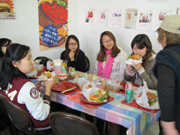 However, Granny’s owner, Harumi Sato, told us that actually she had graduated from a cooking school in Osaka specializing in macrobiotic food (a healthy cooking method centered on unpolished rice and vegetables). The food served at Granny’s, she told us, is made from local ingredients, and absolutely nothing that is harmful to the body is used.
However, Granny’s owner, Harumi Sato, told us that actually she had graduated from a cooking school in Osaka specializing in macrobiotic food (a healthy cooking method centered on unpolished rice and vegetables). The food served at Granny’s, she told us, is made from local ingredients, and absolutely nothing that is harmful to the body is used.
Even so, giant American hamburgers and macrobiotic food just didn’t seem to fit together in my mind. The notion didn’t conform to my conventional wisdom. Usually I think of tasty food as something that is not good for your health, and it is always with a sense of resignation that I go for the yummy dish. Puzzled by this apparent contradiction, I waited with the student monitors as our hand-made hamburgers were prepared.
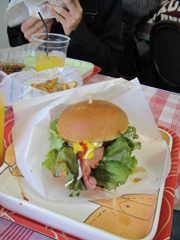 I ordered the Mikkabi Burger, which uses 100% Mikkabi beef from cattle raised on the famous Mikkabi oranges (mikan), and the students ordered the Granny’s Burger, named after the café itself. When the hamburgers came, we all cried out “Wow!” on account of their size. For your information, the Granny’s Burger consists, from the bottom, of bun, mashed potato, natural cheese, grilled onion, 100% beef pate, specially made mango sauce, cheddar cheese, tomato, lettuce, fried egg, thick bacon, bun, and pickle.
I ordered the Mikkabi Burger, which uses 100% Mikkabi beef from cattle raised on the famous Mikkabi oranges (mikan), and the students ordered the Granny’s Burger, named after the café itself. When the hamburgers came, we all cried out “Wow!” on account of their size. For your information, the Granny’s Burger consists, from the bottom, of bun, mashed potato, natural cheese, grilled onion, 100% beef pate, specially made mango sauce, cheddar cheese, tomato, lettuce, fried egg, thick bacon, bun, and pickle.
You can eat the hamburger as you like, but Ms. Sato recommended us to eat them as they were served, wrapped in a paper bag. Tucking into mine, I found both the vegetables and meat to be fresh, juicy, and tasty. The burger is so big, you have to squeeze it as you eat, and that brings out the juice even more. Hence the need for the bag.
 Later I read reviews that the students had posted on the TripAdvisor website, which included the following: “The most delicious hamburger I’ve ever had!” “It was the biggest hamburger in my life! Very satisfied!” “The hamburger was filled with lots of local ingredients, but the bun didn’t get soggy even near the end.” “I only wish this place was closer to where I live.” And “Will come back for sure!” What’s more, all of them gave Granny’s the maximum five-star rating.
Later I read reviews that the students had posted on the TripAdvisor website, which included the following: “The most delicious hamburger I’ve ever had!” “It was the biggest hamburger in my life! Very satisfied!” “The hamburger was filled with lots of local ingredients, but the bun didn’t get soggy even near the end.” “I only wish this place was closer to where I live.” And “Will come back for sure!” What’s more, all of them gave Granny’s the maximum five-star rating.
Kijitei: Pheasant Sashimi and Wild Boar
 For lunch on the second day of the tour we experienced genuine Japanese style at Kijitei—although pheasant and wild boar meat, which is what we had, might not be what people ordinarily eat in Tokyo even if they want to. “Experience” might sound a bit exaggerated, but even Japanese people don’t have many chances to eat pheasant sashimi, so it really was a first experience for the students.
For lunch on the second day of the tour we experienced genuine Japanese style at Kijitei—although pheasant and wild boar meat, which is what we had, might not be what people ordinarily eat in Tokyo even if they want to. “Experience” might sound a bit exaggerated, but even Japanese people don’t have many chances to eat pheasant sashimi, so it really was a first experience for the students.
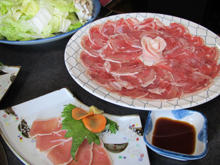 “Pheasant sashimi?” At first the students looked at one another quizzically. But when the pheasant meat came, their eyes sparkled with curiosity. As we waited for the wild boar meat and vegetables to cook in the pot, we began to eat the pheasant meat. One of the students finished off the dish in no time. I wanted to take a photo of him eating, but by the time I had got my camera ready, there was nothing left on his plate. “Plain and delicious!” he exclaimed.
“Pheasant sashimi?” At first the students looked at one another quizzically. But when the pheasant meat came, their eyes sparkled with curiosity. As we waited for the wild boar meat and vegetables to cook in the pot, we began to eat the pheasant meat. One of the students finished off the dish in no time. I wanted to take a photo of him eating, but by the time I had got my camera ready, there was nothing left on his plate. “Plain and delicious!” he exclaimed.
 The pheasant meat is procured from a farm in this district, so it can be eaten all year round, but wild boar is a seasonal specialty available only at this time of the year. The fresh and attractive meat does not harden even when cooked in the pot. It went well with the miso soup, and once we started eating, we just couldn’t put our chopsticks down. The wild boar hot pot has plenty of vegetables as well, so it is a very well-balanced meal.
The pheasant meat is procured from a farm in this district, so it can be eaten all year round, but wild boar is a seasonal specialty available only at this time of the year. The fresh and attractive meat does not harden even when cooked in the pot. It went well with the miso soup, and once we started eating, we just couldn’t put our chopsticks down. The wild boar hot pot has plenty of vegetables as well, so it is a very well-balanced meal.
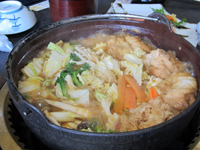 In their questionnaire replies, the student monitors gave a sense of their full stomachs and hearty satisfaction with such comments as “I was really full,” “The word ‘delicious’ just doesn’t do justice to the meal,” and “I felt hospitality in this slightly luxurious and unusual meal.”
In their questionnaire replies, the student monitors gave a sense of their full stomachs and hearty satisfaction with such comments as “I was really full,” “The word ‘delicious’ just doesn’t do justice to the meal,” and “I felt hospitality in this slightly luxurious and unusual meal.”
Unagi Ishikawa: Eel on Rice
 When you think of food in the vicinity of Lake Hamana, probably
the first thing that springs to mind is eels. As the saying goes, you
can’t visit Okuhamanako without eating eels. So on the final day
of the monitor tour, we had lunch at an eel restaurant.
When you think of food in the vicinity of Lake Hamana, probably
the first thing that springs to mind is eels. As the saying goes, you
can’t visit Okuhamanako without eating eels. So on the final day
of the monitor tour, we had lunch at an eel restaurant.
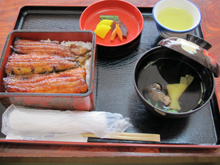
The method of preparing eels at Unagi Ishikawa, a well-known restaurant in Inasa-cho, Okuhamanako, is unique. Generally speaking, there are two ways of preparing eels: the Kanto style and the Kansai style. In the Kanto region, the eel is cut open, grilled, and then steamed to make it soft. In the Kansai region, there is no steaming. But that is not the only difference. The owner of Unagi Ishikawa told us that while the eel is cut open from the back in the Kanto style, in the Kansai style it is cut open from the belly.
Unagi Ishikawa mixes the two styles, cutting open the eel from the back but not steaming it after grilling. While the Kanto style, though time-consuming, produces a beautiful grilled fillet, the Kansai style gives a fatty and fragrant taste. The sauce is quite different from that served in Tokyo as well. According to the owner, since the non-steamed eel itself is fatty and sweetish, a plain and salty sauce is used. We thoroughly enjoyed the taste, which is quite unique to this district and this restaurant.
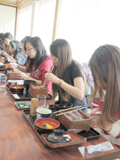 To digress a little, I later did some investigating and came across the popular explanation that people in the Kanto region cut open eels from the back because the samurai of Edo (present-day Tokyo) didn’t like the idea of thrusting a knife into the belly. A more practical reason, according to Wikipedia, is that because the eel is steamed in the Kanto region, if it were cut open from the belly, the outer meat would be so thin that it would drop off the skewer. Personally, I find the popular explanation more interesting . . .
To digress a little, I later did some investigating and came across the popular explanation that people in the Kanto region cut open eels from the back because the samurai of Edo (present-day Tokyo) didn’t like the idea of thrusting a knife into the belly. A more practical reason, according to Wikipedia, is that because the eel is steamed in the Kanto region, if it were cut open from the belly, the outer meat would be so thin that it would drop off the skewer. Personally, I find the popular explanation more interesting . . .
 The student monitors’ comments in the questionnaire and on the TripAdvisor website included the following: “It was a superb lunch to wrap up the monitor tour!” “The meal was simply cooked to perfection!” “It was super flavorful, mouth-watering, and incredibly rich!” “Hands down one of the best eels I’ve ever eaten!” And “Even after a week, I can’t forget the taste!” Obviously the students loved their eels.
The student monitors’ comments in the questionnaire and on the TripAdvisor website included the following: “It was a superb lunch to wrap up the monitor tour!” “The meal was simply cooked to perfection!” “It was super flavorful, mouth-watering, and incredibly rich!” “Hands down one of the best eels I’ve ever eaten!” And “Even after a week, I can’t forget the taste!” Obviously the students loved their eels.
As well as the marvelous lunches described above, the monitor tour students had plenty of other chances to taste the district’s wide range of popular food products, including Japanese confectionery at Irikawa-ya, a shop with a 120-year history; honey products at Nagasaka Apiary; sweet and juicy mandarin oranges at the Marukei mikan farm; soft ice cream made from fresh milk at Tateiwa Dairy Farm; large anmaki cakes (sweet bean paste wrapped in pancake) at Nozawa Seika and Edo abura-age (thin deep-fried slices of tofu) at Nakao Shoten on the approach to Hokoji temple; and, last but not least, the gelato on sale at a shop at Ryugashido Cavern, which was chosen by Shizuoka Prefecture bus guides as the best ice cream in the prefecture. The tour was a wonderful opportunity for the students to learn about the immense attractions of Japan’s rich food culture.
- Category
- Cusine、Food、Local specialties、News、Restaurants、Travel
